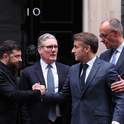The battle for the Labour Party has taken a decisive turn with confirmation that Owen Smith will challenge Jeremy Corbyn for the leadership. Smith, a former shadow Work & Pensions spokesman, secured 90 nominations from Labour MPs and MEPs—far more than the 51 he needed to get on the ballot—and more than Angela Eagle, who was also standing. Despite reportedly securing 72 nominations, Eagle has stepped aside to allow Smith a clear run at Corbyn. Labour’s ruling National Executive Committee (NEC) had already controversially decided that Corbyn would not require nominations to be on the leadership ballot, as the rules were unclear as to whether incumbents needed renominating during a challenge.
Labour’s leadership selection system was created during Ed Miliband’s leadership and is a variation of one-member-one-vote. Individual party members are permitted to vote, as are those who have signed up as either affiliated supporters—members of Labour-affiliated trade unions who have enrolled to vote—and registered supporters, who can vote on payment of a fee. Affiliated and registered supporters must also sign their agreement to Labour’s values.
The system’s first use in 2015 was accompanied by controversy. New members surged into the party, mainly with the intention of voting for Corbyn. The party’s membership doubled between the general election in May and the end of the year. Meanwhile, registered supporters had to pay only £3 to vote and 105,000 did so, 84 per cent of those voting for Corbyn. Many have since signed up as full members. These new members and supporters leaned heavily to the left and there were complaints about entryism and “flashmob” democracy. A vetting process weeded out some trouble-makers and members of far-left groups, but not all or probably even most.
To avoid these problems, the NEC ruled that there would be a cut-off point for members to be allowed to participate in 2016. Only those who had been members for at least six months (on or before 12th January) could vote, angering the 100,000 who have joined the party since the EU referendum (though in theory they could still sign up as registered supporters). Meanwhile, the fee for registered supporters was increased to £25, which will likely put off many, including students. The registration period is open for only two days, closing today. Affiliated supporters must have belonged to their organisations for at least six months. These rulings were expected to disadvantage Corbyn.
Supporting nominations from constituency Labour parties open today. In addition, Corbyn will be hoping to win the backing of the Unite union, Labour’s biggest affiliate. Unite’s leader, Len McCluskey, has thus far remained loyal to Corbyn. But that could easily change.
The contest now goes to Labour members and supporters in the country. A series of hustings will take place where the candidates will face off. On the basis of last year’s experience, Corbyn will also likely hold his own rallies, organised by his grassroots support group, Momentum. Another feature of the 2015 contest that will certainly be repeated this year is the cyber-campaign, where Corbyn’s supporters are particularly strong. Last year’s contest was the first genuine social-media leadership election in Britain. Social media can be used to share talking points, mobilise supporters and target opponents.
The vote is by postal ballot (full members only) or online voting. The votes of members, affiliated supporters and registered supporters are counted together—there are no separate weighted sections. The alternative vote (preferential voting) is used and the winning candidate must secure over 50 per cent. As there are only two candidates, there will not be multiple counts and reallocations of votes. Ballots are sent out in the week commencing 22nd August and must be returned by 21st September. A special conference in Liverpool will announce the result on 24th September.
Corbyn’s chances of victory received a boost on Tuesday with a YouGov poll of party members that showed him defeating Smith 62-38 in a head-to-head (once “don’t knows” were excluded). Among members who joined before the 2015 general election, Smith led 53-47, but among those who’ve joined since, Corbyn enjoys a huge 76-24 lead. They are the bedrock of his support.
But it would be unwise to write off Smith just yet. Labour is badly divided and he will pitch himself as the unity candidate who can bring together all factions. He will argue that his leftist politics chime with the membership while he can also, vitally, command the support of MPs. He will present himself as the only candidate acceptable to the whole party, both inside and outside parliament. He can point to the chaos of MPs refusing to serve on Corbyn’s front-bench and highlight the genuine danger of a split if Corbyn is re-elected.
Smith is barely known—but this is likely to play to his advantage. YouGov’s poll showed that 69 per cent of members know little or nothing about him. That could allow him to define his own image in the campaign—provided his enemies don’t define it for him first. He can present himself as the competent face of the left.
As for Corbyn, he retains strong support but there is a growing body of opposition to him among the members: 41 per cent in YouGov’s poll rated him doing badly as leader. The contest is still Corbyn’s to lose but if Smith can convince the left that its goals would be better advanced through unity, electability and competence, he could yet pull off a surprise.
How does the Labour leadership contest work?
Who is paying £25?
July 20, 2016












